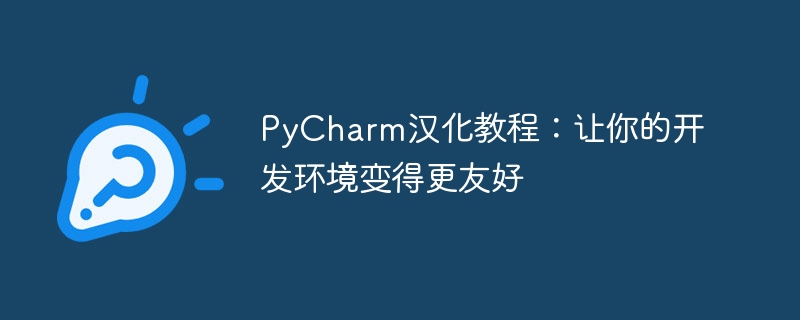

PyCharm Chinese Tutorial: Make your development environment more friendly
Introduction:
PyCharm is a powerful Python integrated development environment (IDE) , which provides many convenient functions and tools to improve development efficiency. Not only that, PyCharm also supports multiple languages and frameworks and is extensible. However, for some non-English native developers, using the English interface may cause some confusion. Therefore, this article will introduce how to Chineseize PyCharm to make the development environment more friendly.
Step 1: Download the Chinese package
First, we need to download the Chinese package for PyCharm. This Chinese package can convert PyCharm's interface into Chinese. You can find trustworthy download sources on the Internet by searching for the keyword "PyCharm Chinese package download". After the download is complete, you will get a file with a .jar suffix.
Step 2: Install the Chinese package
Before starting PyCharm, we need to install the Chinese package we just downloaded into PyCharm. Please follow these steps:
Step 3: Activate the Chinese package
Once the Chinese package is installed and PyCharm is restarted, we need to activate it. Please follow these steps:
Step 4: Verify the Chinese translation effect
Now, we can verify whether the effect of the Chinese translation package is effective. After reopening PyCharm, you will find that most of the text in the interface has been translated into Chinese. In the editor, you can also see this change through the right-click menu.
Extra Tips:
If you want to undo the effect of the Chinese package, you can follow the steps below:
Conclusion:
By Chineseizing PyCharm, we can make the development environment more friendly and easier to use. Whether it is for developers whose native language is not English, or for developers who are more accustomed to using Chinese interfaces, Chinese PyCharm can provide a better user experience. I hope this article can help you and make you more comfortable using PyCharm for development.
Code example:
The following is a simple Python code example that shows how to use PyCharm to write and run code:
# 计算阶乘的函数
def factorial(n):
if n == 0 or n == 1:
return 1
else:
return n * factorial(n-1)
# 输入一个整数并计算其阶乘
num = int(input("请输入一个整数:"))
result = factorial(num)
print(f"{num}的阶乘为:{result}")The above code implements a function that calculates factorials, and Gets the integer to calculate the factorial from user input. Finally, print out the calculation results. This is just a simple example, you can write more complex code in PyCharm according to your needs and use its powerful debugging features to help you debug and test your code.
I hope this article will be helpful to you in Chineseizing PyCharm and using PyCharm for Python development. I wish you happy learning and writing elegant and efficient code!
The above is the detailed content of Browse the Chinese version of PyCharm to improve the usability of your development environment. For more information, please follow other related articles on the PHP Chinese website!
 How to change pycharm to Chinese
How to change pycharm to Chinese
 pycharm installation tutorial
pycharm installation tutorial
 How to learn python programming from scratch
How to learn python programming from scratch
 How to solve the problem that pycharm cannot find the module
How to solve the problem that pycharm cannot find the module
 How to install pycharm
How to install pycharm
 The difference between python and pycharm
The difference between python and pycharm
 How to configure the pycharm environment
How to configure the pycharm environment
 How to install the pycharm interpreter
How to install the pycharm interpreter




